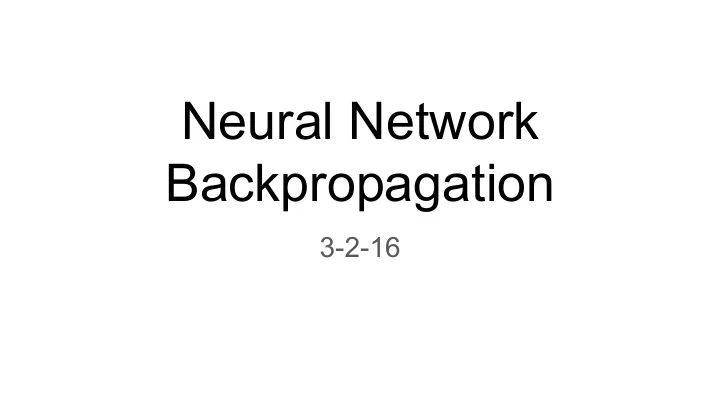

Neural Network Backpropagation 3-2-16
Recall from Monday... Perceptrons can only classify linearly separable data.
Multi-layer networks ● Can represent any boolean function. ● We don’t want to build them by hand, so we need a way to train them. ● Algorithm: backpropagation. ○ You’ve already seen this in action in yesterday’s lab.
Backpropagation networks sigmoid ● Backpropagation can be applied to activation functions any directed acyclic neural network. -0.5 ● Activation functions must be 0.2 differentiable. 2.7 0.8 ● Activation functions should be non- 3.0 -0.3 -1.9 linear. -1.2 -1.6 OK not OK 1.5 2.2 0.1 ● Layered networks allow training to be parallelized within each layer.
Sigmoid activation functions ● We want something like a threshold. ○ Neuron is inactive below the threshold; active above it. ● We need something differentiable. ○ Required for gradient descent.
Gradient descent ● Define the squared error at each output node as: ● Update weights to reduce error. ○ Take a step in the direction of steepest descent: w 0 derivative of w 1 learning rate error w.r.t. weight
Computing the error gradient … algebra ensues ...
Gradient descent step for output nodes 2 1.04 2 1 -.97 1.2 -1 1.2
Backpropagation Key idea: at hidden units, use the next-layer change instead of the error function. ● Determine the node’s contribution to its successors. w 0 w 1 ● Update incoming weights using this “error”
Backpropagation algorithm for 1:training runs for example in training_data: run example through network compute error for each output node for each layer (starting from output): for each node in layer: gradient descent update on incoming weights
Exercise: run a backprop step on this network 2 -0.5 0.2 2.7 t = 0.1 0.8 -0.3 3.0 0 -1.2 -1.6 1.5 t = 0.8 0.1 -1
Recommend
More recommend